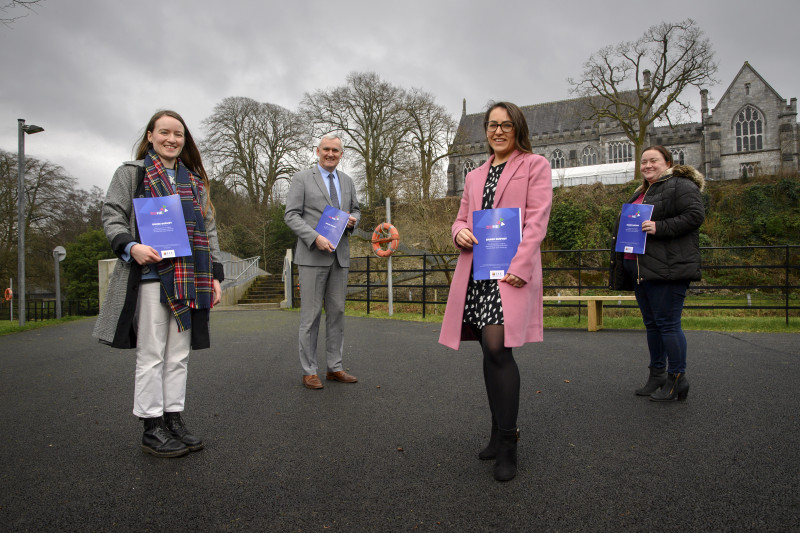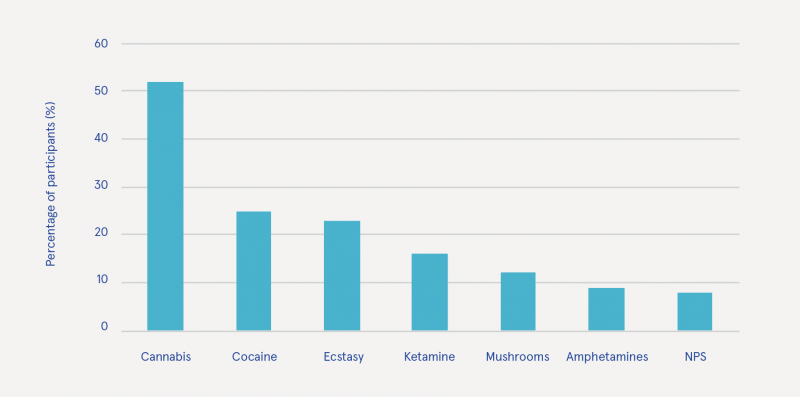Millar, Sean (2022) Drug use among students in higher education in Ireland. Drugnet Ireland, Issue 81, Spring 2022, pp. 1-4.
| Preview | Title | Contact |
|---|---|---|
|
PDF (Drugnet Ireland 81)
712kB |
The use of illicit drugs is a public health issue worldwide with the annual prevalence of drug use increasing over the past decade.1–4 International research from Ireland, the United Kingdom, and the United States suggests that approximately one-quarter of students in higher education institutes (HEIs) report using illicit drugs within the last 12 months.5–10 However, there is a lack of recent comprehensive data on drug use among students in higher education in the Republic of Ireland.
In September 2019, the then Minister of State for Higher Education, Mary Mitchell O’Connor TD, established a rapid response group to address the issue of drug use in higher education in Ireland. Minister O’Connor tasked the group with recommending a suite of specific actions appropriate to the higher education setting and in line with the Government’s national drugs strategy, Reducing Harm, Supporting Recovery: a health-led response to drug and alcohol use in Ireland 2017–2025,11 with the overall aim being to reduce harms experienced by students through the use of drugs. The My Understanding of Substance-use Experiences (MyUSE) research team in University College Cork (UCC), led by Dr Michael Byrne, was selected to develop the Drug Use in Higher Education in Ireland (DUHEI) Survey.12 The survey population included undergraduate and postgraduate students aged 18 years and over in publicly funded HEIs. The sampling strategy that was used ensured that a random representative sample of the student population was invited to participate in the survey.

At the launch of the DUHEI report were (L to R): Ahsa Woodhouse, president of UCC Students’ Union; Dr Michael Byrne, DUHEI principal investigator and head of UCC Student Health Department; Sam Dick, DUHEI project manager, UCC School of Public Health; and Lisa Ryan, DUHEI research assistant

Source: DUHEI, 2022
Figure 1: Type of drugs used by DUHEI survey participants who reported ever using an illegal drug
Twenty-one publicly funded HEIs in the Republic of Ireland participated in DUHEI. Data collection was completed in early 2021 via a secure online survey platform. Over 11,500 participant responses were included for analysis, of which 60% were female. The median age was 21 years; 81% were undergraduates and 90% were European Union students. The main findings from the DUHEI survey are discussed below.
Student drug use
Results from the DUHEI survey revealed that over one-half of participating students reported ever using an illicit drug, with over one-third reporting drug use in the last year (recent use) and one-fifth reporting using drugs in the last month (current use). Among students reporting ever using an illegal drug (see Figure 1), the most commonly used drugs were cannabis (52%), cocaine (25%), ecstasy (23%), ketamine (16%), mushrooms (12%), amphetamines (9%), and new psychoactive substances (NPS) (8%). This order of prevalence of drugs/drug types was maintained across all three user groups.
Current users of cannabis reported doing so approximately twice weekly, while current users reporting cocaine or ketamine use did so approximately once monthly. One in four males and one in six females indicated current drug use; four out of 10 current users reported using two or more drugs on the same occasion. For the majority of drug types, the age of first use was between 19 and 21 years, whereas for cannabis it was between 16 and 18 years. One in four current users reported using cannabis when they were less than 16 years of age.
Harms and effects
Although a majority of recent and current users felt that their drug use had neither negative nor positive effects on many aspects of their lives, the survey found that based on Drug Abuse Screening Test (DAST-10) scores, one in three recent
users and over one in two current users were at moderate or substantial risk of harms arising from their drug use. Just under one in two recent or current users reported having unprotected or unintended sex, or getting into fights, on at least one occasion in the preceding year. Six out of 10 current users reported engaging in sexual activity while under the influence of drugs and one in three of these reported that the drug used was cocaine. In addition, one in three current users believed that drugs have a negative effect on student life.
Changing drug use behaviours
One in three users reported that they had tried to reduce their drug use. The most commonly reported means of changing drug use were avoiding environments where drugs are used and avoiding friends and peers who use drugs. For all participants, face-to-face interventions were perceived as being more effective than online interventions to reduce drug-related harms. Education was perceived as being the least effective intervention to reduce harm, while counselling was perceived as being the most effective intervention to reduce harms from drug use.
Other findings
Other findings from the DUHEI survey include the following:
- Less than one in 20 participants reported using smart drugs (i.e. study drugs/nootropics/cognitive enhancers), while one in 10 current users reported using smart drugs to enhance their academic performance.
- Over one in 20 participants reported that they previously had a drug or alcohol problem; for one-half of these, it had resolved within the previous two years.
- One in four of those with a previous drug or alcohol problem identified themselves as currently in active recovery.
- Of those who had used drugs during the Covid-19 pandemic, one in three had decreased their use, while just less than one in four had increased their use over this period.
- One in 10 participants reported using drugs for the first time since the Covid-19 pandemic began.
Conclusions
The study authors noted that over one-half of those who currently use drugs identified in the DUHEI survey were at moderate or substantial risk of harm from drug use based on their DAST-10 score. They suggest that interventions targeted at the level of the individual are clearly required in Irish HEIs. In addition, interventions at an institution and sector level are also required to support those who do not use drugs and to aid the recovery and reduce the harms experienced by those who do. They also recommend that the DUHEI survey should be repeated at five-yearly intervals to monitor trends in drug use prevalence, attitudes, and behaviours among students in Ireland.
1 European Monitoring Centre for Drugs and Drug Addiction (2012) The state of the drugs problem in Europe: annual report 2012. Luxembourg: Publications Office of the European Union. https://www.drugsandalcohol.ie/18783/
2 World Health Organization (2016) The health and social effects of nonmedical cannabis use. Geneva: World Health Organization. https://www.drugsandalcohol.ie/25267/
3 United Nations Office on Drugs and Crime (2018) World drug report 2018. Vienna: United Nations. https://www.drugsandalcohol.ie/29252/
4 Substance Abuse and Mental Health Services Administration (2017) Key substance use and mental health indicators in the United States: results from the 2016 national survey on drug use and health. Rockville, MD: Center for Behavioral Health Statistics and Quality. pp. 17–44. Available online at: https://store.samhsa.gov/
5 Bennett TH and Holloway KR (2014) Drug misuse among university students in the UK: implications for prevention. Subst Use Misuse, 49(4): 448–455.
6 Cahill E and Byrne M (2010) Alcohol and drug use in students attending a student health centre. Ir Med J, 103(8): 230–233. https://www.drugsandalcohol.ie/14043/
7 Hope A, Dring C and Dring J (2005) College Lifestyle and Attitudinal National (CLAN) Survey. Dublin: Health Promotion Unit, Dept of Health and Children. https://www.drugsandalcohol.ie/4327/
8 Dooley B, O’Connor C, Fitzgerald A and O’Reilly A (2019) My World Survey 2: The National Study of Youth Mental Health in Ireland. Dublin: University College Dublin/Jigsaw National Centre for Youth Mental Health. https://www.drugsandalcohol.ie/31343/
9 Davoren MP, Shiely F, Byrne M and Perry IJ (2015) Hazardous alcohol consumption among university students in Ireland: a cross-sectional study. BMJ Open, 5(1): e006045. https://www.drugsandalcohol.ie/23350/
10 Skidmore CR, Kaufman EA and Crowell SE (2016) Substance use among college students. Child Adolesc Psychiatr Clin N Am, 25(4): 735–753.
11 Department of Health (2017) Reducing Harm, Supporting Recovery: a health-led response to drug and alcohol use in Ireland 2017–2025. Dublin: Department of Health. https://www.drugsandalcohol.ie/27603/
12 Byrne M, Dick S, Ryan L, Dockray S, Davoren M, Heavin C, et al. (2022) The Drug Use in Higher Education in Ireland (DUHEI) Survey 2021: main findings. Cork: University College Cork. https://www.drugsandalcohol.ie/35515/
B Substances > Cannabis / Marijuana
B Substances > Hallucinogens / Psychedelics > Mushrooms (psilocybin)
B Substances > CNS stimulants
B Substances > Cocaine
B Substances > New (novel) psychoactive substances
N Communication, information and education > Educational environment / institution (school / college / university)
N Communication, information and education > Educational environment / institution (school / college / university) > Student behaviour
T Demographic characteristics > Young adult
T Demographic characteristics > Undergraduate or graduate college student
VA Geographic area > Europe > Ireland
Repository Staff Only: item control page